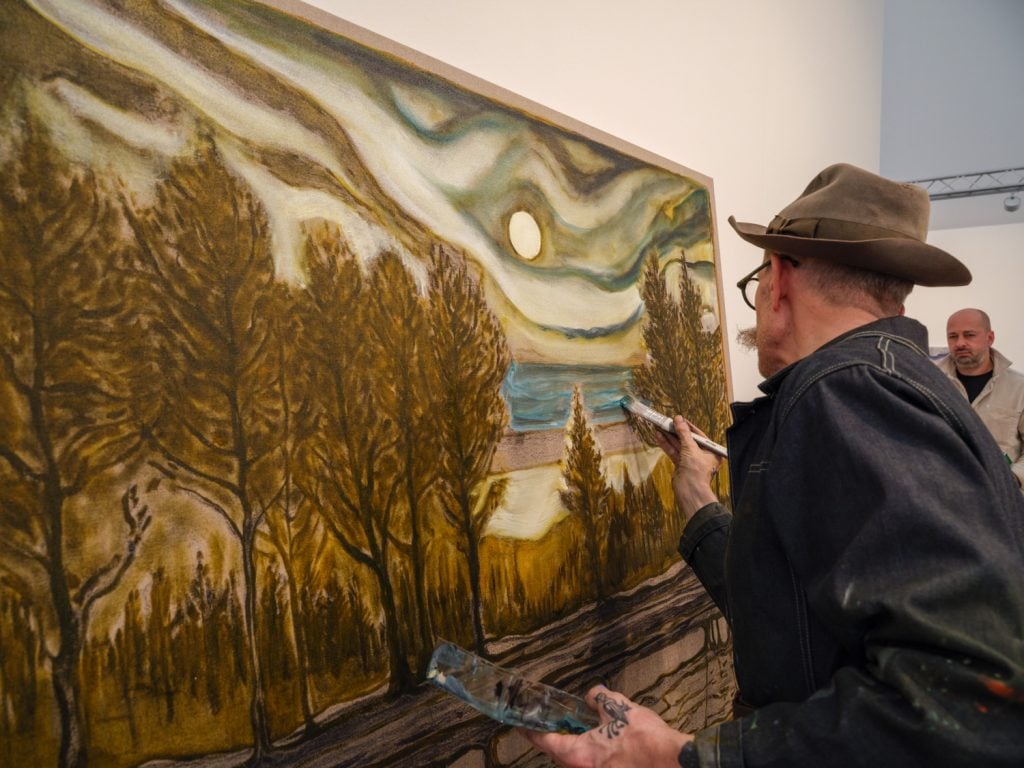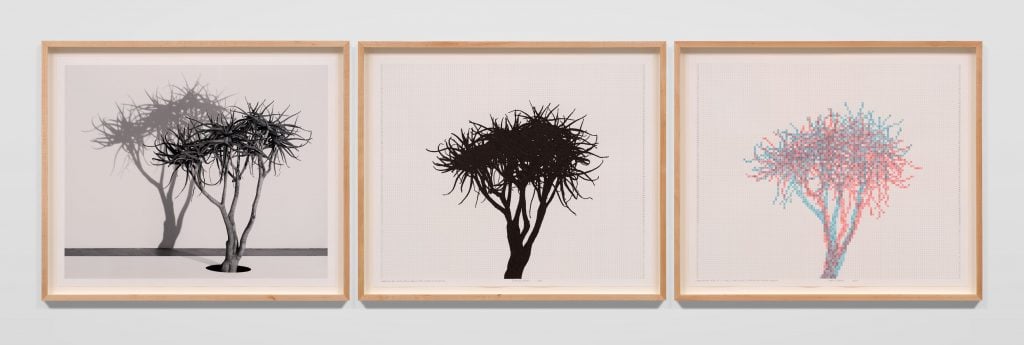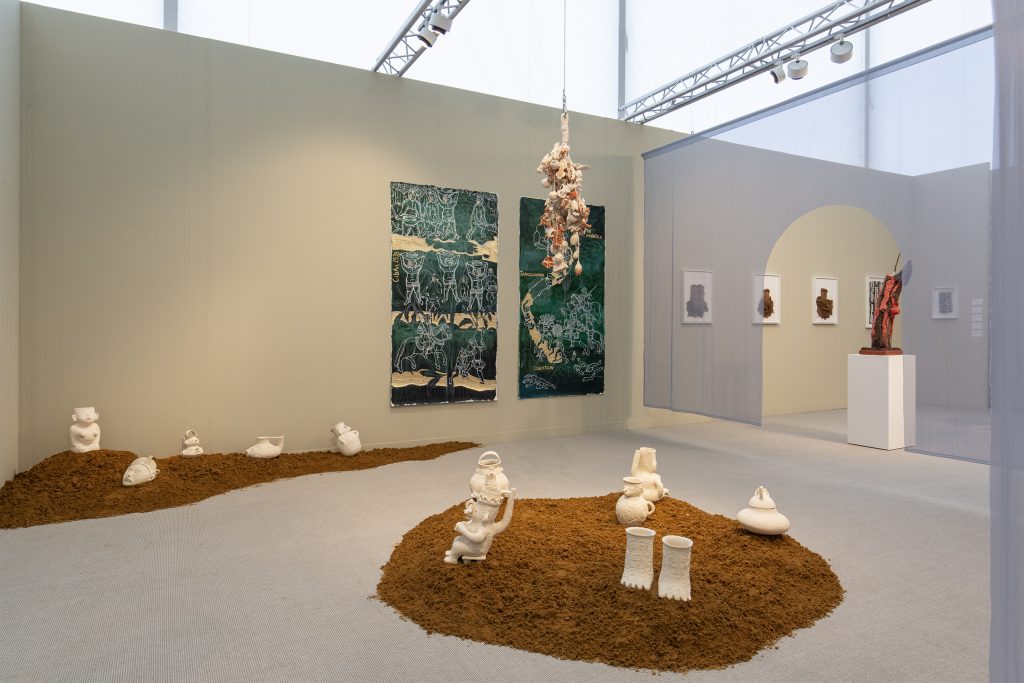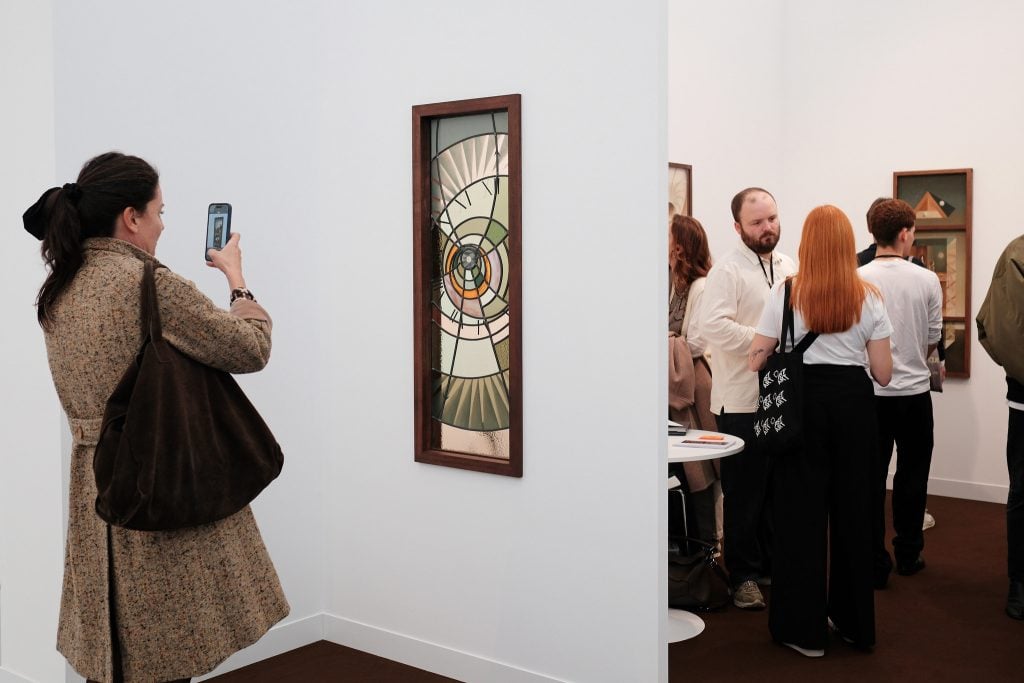Art Fairs
Sales Are Slow at Frieze London, But Focus on Fresh Talent Thrills
David Zwirner placed a $2.2 million Lisa Yuskavage, and Lehmann Maupin found a buyer for a painting that Billy Childish made on site.

David Zwirner placed a $2.2 million Lisa Yuskavage, and Lehmann Maupin found a buyer for a painting that Billy Childish made on site.

Margaret Carrigan

Sales were not exactly rolling in during the opening of Frieze London on Wednesday, but no one really expected them to, given the market’s present stagnation amid geopolitical uncertainty and high interest rates.
The fair has some competition this year from the rebranded Art Basel Paris, which opens next week, and this seems to have fueled a slight but much-needed refresh of its offerings. For its 21st edition, Frieze London has aimed to highlight smaller galleries and younger artists in an effort to get back to its roots as a platform for groundbreaking contemporary art.
An updated layout of the fair has pushed such emerging outfits to the fore. Frankly, I was relieved to be met with something, anything, other than a Gagosian booth. The two understated but potent solo artist presentations that were selected to grace the entrance have welcome substance, especially in an era (and an economy) when galleries have erred on the side of bringing apolitical works.
The British American artist Danielle Dean’s latest watercolors ($7,000 to $27,000), on view at the booth of New York’s 47 Canal, chart the evolution of her childhood hometown, Hemel Hempstead in England, from a small medieval village to a bastion of postwar social housing to, now, an industrial hub hollowed out by post-Brexit austerity.
Next door, drawings and photographs by the Pakistan-born, Berlin-based artist Bani Abidi, brought by the Kolkata gallery Experimenter, focus on what she refers to as our current “genocidal moment.” The works, all priced under $200,000, were created in response to the Israel-Gaza War.

Bani Abidi’s “Seeking Comfort in a German Chair” series at Experimenter’s booth. Photo: Margaret Carrigan.
A series of drawings, “Fragments from a Nightmare,” feature sketches of public figures who have spoken out against the war, among them film director Jonathan Glazer, who decried the “dehumanization” of Israelis and Gazans in his Oscars speech this year, and lawyer Adila Hassim, who represented South Africa in the Gaza genocide case it brought before the International Court of Justice. Opposite, a photographic series, “Seeking Comfort in a German Chair,” has the artist sitting in many uncomfortable-looking poses in various chairs, as well as eating watermelon—a symbol of Palestinian resistance and support—off the seat of another.
Experimenter director Priyanka Raja said she is “grateful” to Frieze’s organizers for “thinking about the work that needs to be shown and supported right now on a global stage.” International institutions and several collectors had expressed interest in the work, she said; Tate later announced the acquisition of three works by Abidi.
In a very literal instance of centering artists, Lehmann Maupin brought in British painter Billy Childish to create new works on site, with his two children acting as apprentices. The performance drew a crowd to its booth. By mid-afternoon, the gallery had sold 10 works priced between $50,000 and $100,000 to collectors from the U.K., U.S., and Italy. That included river trees, one of the paintings being made in real time—meaning that, despite the market downturn of the last 18 months, the gallery managed to move a work before the paint even dried, just like in the boom years.
Hauser and Wirth’s booth has a solo presentation by the L.A. artist Charles Gaines. The influential conceptual artist, 80 this year, has a show up at the Fresno Art Museum in California, is about to open one at the Phoenix Art Museum, and will have a retrospective at the Art Institute of Chicago in 2025.

Charles Gaines, Shadows XIV: Aloe, Set 2, 2024. © Charles Gaines Courtesy the artist and Hauser and Wirth Photo: Keith Lubow
Neil Wenman, the gallery’s global creative director, said there is “developing demand” for the artist’s work in Europe. Of the 24 works on view—all made in 2024, riffing on a 1980 grid painting (also on offer)—five had sold by the end of the day. The new works are priced between $180,000 and $200,000. The 1968 work, priced at $250,000, has yet to sell.
Frieze London’s new layout, which positioned many of the mega galleries toward the back of the fair, allowed the gallery to reconsider its approach about what to show, Wenman said. “It was an opportunity to do something different, more educational.”
Not everyone loves the new layout. While David Zwirner told me that he was happy with his “spacious” position at the front end of the “D” section, next to Hauser and Wirth, he suggested that some of his peers were less pleased.
Overall, however, Zwirner was not thrilled by the sales so far. “Ehhhh, I need more,” he said.
By 5 p.m., the gallery had sold several works, including two paintings by Lisa Yuskavage, for $160,000 and $2.2 million (one of the most expensive works to sell at Frieze London thus far). Two paintings by Yayoi Kusama sold for $670,000 and $720,000, and a sculpture by Rose Wylie sold for $120,000, as did a new painting by Sasha Gordon, whom the gallery started representing last month; at 26, she is the youngest artist on its roster. A large, untitled painting from 2015 by Noah Davis, one of the artist’s last before he died, was priced at $2.4 million and had yet to sell.

Noah Davis, Untitled (2015) at David Zwirner. Photo: Margaret Carrigan.
There was speculation before the fair that some international collectors, especially those coming from the U.S., would arrive later in the week, en route to Art Basel Paris, which launches its third and largest edition on October 15.
“I do think more Americans will be coming later in the week,” Isabella Icoz, a partner at Lehmann Maupin, said.
Arianne Piper, a London-based advisor, said American collectors and dealers “do seem to have a soft spot for Paris, especially with the return of the Grand Palais,” which will host Art Basel, after undergoing a restoration. She said that she has about the same number of clients attending each fair this year, “but I have heard from others that some dealers have decided to prioritize Paris.”
The U.S.-based advisor Andrea Hazen said she has seen “equal interest in the two fairs” from her clients and is planning to source works from both. “I feel like a lot more Americans will be heading to London and Paris this year than last,” she said.
It’s not just the allure of Art Basel Paris that has pulled some attention away from Frieze. In recent years, many have said the fair has lost the edginess for which it was originally known. Brexit has also created a burdensome business landscape in the U.K., tarnishing London’s status as an international trade hub, even as it remains the third-largest art market, with annual sales greater than the rest of Europe combined.
Even if the London market is on its back foot, it remains an “extraordinary arts ecosystem” and “an enduring draw for artists and collectors alike,” according to dealer Thaddaeus Ropac. At his gallery’s booth, Study of Santa Teresa (2024) by Robert Longo sold for $90,000. (Last night, Longo opened a solo show at Ropac’s Mayfair space.) Two works by Zadie Xa also sold, both for around $78,000, as did Joan Snyder’s Mud & Lace (2024) for $200,000 and Elizabeth Peyton’s Lara, August 2021 (2021) for $225,000.

Patron Gallery’s booth in the “Smoke” section of Frieze London. Photo: Image by Gabriele Abbruzzese. Courtesy of the artist and Patron.
Even if Frieze London has less of an adventurous reputation these days, it remains a key stepping stone for smaller outfits—and a major platform for emerging artists.
“Being here is big for us,” said Emanuel Aguilar, the cofounder of Chicago’s risk-taking Patron Gallery, which turns 10 this year. The gallery has an installation of ceramic works displayed on mounds of sand by the Indigenous Mexican artist Noé Martínez in the fair’s stunning “Smoke” section.
Organized by Pablo José Ramirez, the curator of Los Angeles’s Hammer Museum and former curator of Indigenous and First Nations art at Tate Modern, “Smoke” rewards visitors for making it all the way through the tent. Devoted to ceramic works that explore diasporic and Indigenous histories, it features 11 artists from eight galleries selected by Ramirez. The displays are divided by a smoke-inspired transparent mesh, rather than rigid booth walls.
Martínez’s works, priced between $10,000 and $15,000, are inspired by pre-conquest Huastecan pottery and were previously shown at the 2023 Gwangju Biennial. The artist’s new paintings on unstretched cotton draw from pictorial storytelling traditions of post-conquest Mexico to depict historical instances of erasure and displacement.
“We’re glad to be part of this section, which has a much more exhibition-style feel to it,” Aguilar said, adding that “many fairs have become predictable,” which is “boring” for both collectors and dealers.

Ginny on Frederick, Frieze London 2024. Photo by Linda Nylind. Courtesy Frieze / Linda Nylind.
Frieze London has a ways to go before it could be considered edgy again. But even this most modest refresh is a breath of fresh air in a staid U.K. market. It should take more risks going forward.
At the booth of London’s Rose Easton, in the fair’s Focus section (which is closer to the front this year), the London-based dealer has an installation by Eva Gold with works priced between $8,000 and $23,000. Easton, a first-time exhibitor, placed two of Gold’s works within the first hour of the fair.
“This is my hometown fair, I’ve been coming here since I was young,” Easton said. “It’s an important moment for me, and I’m glad to bring Eva’s work, which I love for her uncanny exhibition-making process, and test it out in a more fast-paced, commercial environment.”
At the booth of the critically acclaimed upstart Ginny on Frederick, founding director Freddie Powell said, “Frieze literally changed the trajectory of the gallery” after participating for the first time last year. (It launched in 2020 in a sandwich shop in London’s unremarkable but central Farringdon area.) Ten new stained-glass works and beaded-and-painted panels by Charlotte Edey, priced between $13,000 and $17,000, had sold out by noon.
Frieze London runs until Sunday, October 13 at Regent’s Park, London.